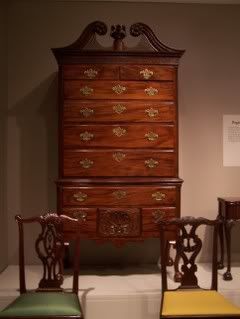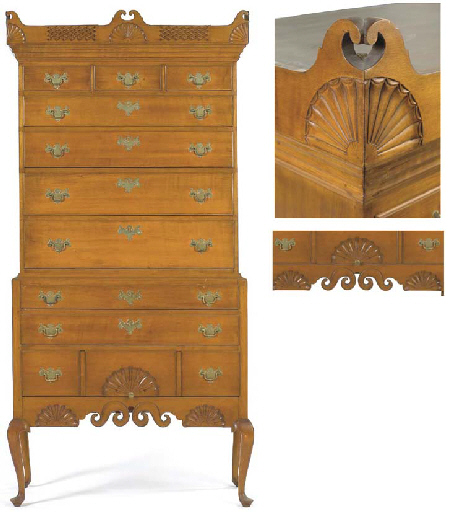Scots-Irish Furniture Styles of Late 18th Century New Hampshire
The Wood Whisperer Guild is at is again and embarking on its summer group build. This time it is a chest of drawers. The “approved” plan is actually almost identical to the chest I built in July of 2009 and you can find a 3 part series on it starting here.
In my non-stop effort to be difficult, I am ratcheting things up a notch and building a 4 drawer chest based on the designs of Major John Dunlap and Lieutenant Samuel Dunlap of New Hampshire. The Dunlaps are part of a legacy of immigration that took lowland Scots who emigrated to the Ulster area of Northern Ireland and then eventually on to New Hampshire and Maine in the late 17th and early 18th centuries. This nomadic existence was mostly driven by religious persecution since these people were mostly Presbyterian living among predominantly Catholic societies. In fact, once settled in New Hampshire primarily, some of this persecution continued as it was assumed these Scots-Irish were Catholic based upon their nationalistic origins. It seems that the Scots-Irish spent more time declaring what they were not than defining who they were. This checkered past yields the name Scots-Irish and the designs from this group are endearing, whimsical, idiosyncratic, and just plain weird. It is interesting because the towns of Antrim, and Londonderry are not so far from the major style hub of Boston that dictated most of the furniture details in New England. The Dunlaps worked primarily during the Rococo or Chippendale period so being in New England we would expect detailed, asymmetric carvings, massive structures with lower centers of gravity and powerful ambiance like this Highboy built in Boston around 1750. I took this pictures at the Winterthur Museum by the way.

In contrast the Dunlap cabinetry style adds an element of whimsy with unique and elaborate carvings unlike anything we see coming out of New England at the time. In some ways the ornamentation hearkens back to a Baroque style. Basket woven galleries and almost Celtic derived scrollwork adorn the tops and bottoms of the cases. A signature flowered ogee molding is seen as a punctuation mark between elements and upon closer examination seems to be a minimalist version of architectural egg and dart moldings. Deep lower cases are prevalent that seem to embrace the Chippendale massiveness but take it one step further. With the deeper lower cases came more elaborate scrollwork as well. This piece is somewhat iconic of this style and includes much of what I just mentioned.

Here is another example taken from Paul Rulli’s website. Notice the somewhat disproportionate upper and lower cases.

A Paul Rulli Dunlap reproduction
Here is a close look at the iconic basket weave and Peacock fan typically seen on Dunlap pieces. You will also see the flower ogee molding above and below the top gallery.

Paul Rulli's fine carving work on the Dunlap reproduction
I will be curious to hear some of your thoughts on this piece. It is certainly different and in my opinion somewhat ugly. I think the offensive nature of it is what really attracted me and stirred me into further research. In many ways this style has grown on me and I believe when taken in moderation it can yield some amazing pieces. I think some of the most constructive design exercises can be done when you force yourself to play in areas that you don’t like. So if we take away some of the disproportions of the above piece, mellow down the carvings a little, and apply the chest of drawer form to it we end up with this piece which will be the subject of my next Guild build.

This chest was mostly likely built by Lt. Samual Dunlap around 1795 and you will see that the proportions are more pleasing but the stubby feet keep that extreme low center of gravity to the piece. The distinctive flowered ogee molding is present as well. I think some of the reasons for this overall mellowing of the style is that period in which this was constructed. The idiosyncratic Dunlap style was really one for the American Revolution generations and as we move into the 19th century, this began to lessen.
So I see many challenges ahead during this build. For one the integral bead detail on the case and drawer blades will be a test since each joint will have to be mitered to keep a continuous flowing line throughout. This will be my first attempt at ball and claw feet as well and I am already gearing up for that by doing some practice pieces in Poplar. The chest will be done in Cherry and if possible curly Cherry for the drawer fronts. So stay tuned for updates here as I start out on my next project.
By the way, I highly recommend the book “The Dunlap Cabinetmakers” for a much more detailed look into this style of furniture.


